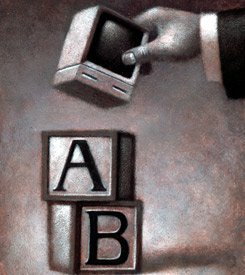Online Learning: Virtual Valedictory
Distance education goes mainstream.

PREDICTION: Online learning for students and teachers will grow exponentially.
In March 2006, Michigan took a giant step forward in the world of online learning. As a key component of its new high school curriculum, the state required that all public school students complete an online course before graduating. It was a bold move, signaling for the first time a state's belief in the intrinsic value of online education.
"If Michigan is going to achieve economic growth, we must give all students the tools they need to succeed in college and the workplace," Governor Jennifer M. Granholm declared shortly after the state legislature approved the new requirement. And with the stroke of her pen, every high school student in the state must now take all or part of at least one course online.
The question now is, "Where Michigan leads, will others follow?"
The last several years have been marked by notable growth in the number and the popularity of online courses, especially for highs chool students. Recently, for example, the Sloan Consortium estimated that 700,000 public school students were enrolled in one or more online classes during the 2005-06 school year. This figure does not necessarily indicate a commitment to an alternative way of teaching and learning; however, most schools, school districts, and states have offered online courses as a cost-effective way to address staffing and scheduling problems. But the paradigm may be changing, says Anthony G. Picciano, coauthor with Jeff Seaman of the organization's survey on K-12online learning.
Early adopters recognize the pedagogical benefits both of teaching and taking courses online, Picciano explains, and to appreciate the role of online learning in developing well-rounded students. He points to the growth of blended classes, which combine online and in-class components, as an example of a new appreciation for the value of integrating varying instructional approaches. According to Picciano and Seaman's survey, two-thirds of districts involved expect enrollment in blended courses to grow, and they predict a 23 percent enrollment increase over the next two years.
Just as acceptance of the value of online learning for students is growing, the role of virtual courses in continuing education for teachers is expanding. The National Education Association and the American Federation of Teachers now offer professional-development courses online, including some of their most popular classes. For veteran teachers who've never experienced this type of education, these forays into virtual learning may be the key to increasing the number of educators who teach this way, too.